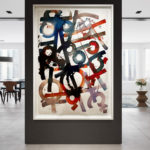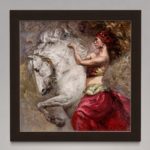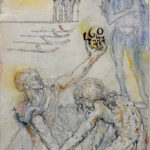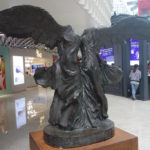Weightless and sprightly, American master sculptor Richard MacDonald has long captured our collective imaginations with his caught-in-time sculptural glimpses of ballerinas, dancers, athletes and mimes. Each figure is typified by a lightness and fluidity which is unequaled in today’s sculptural world. This fascination with motion makes it understandable why MacDonald became enamored with the famed French Canadian troupe Cirque du Soleil several years ago. Cirque has reinvented what we thought a circus was, and in the process challenged our ideas of what the human body can and cannot do. Guy Laliberté, founder of Cirque du Soleil, created a veritable dynasty with his unusual blend of circus-like performances and street entertainment starting in 1984. His enigmatic shows, “O”, “Saltimbanco”, “La Nouba”, “Allegria” and others presented viewers with gravity-defying feats in a variety of visually-perplexing self-contained vignettes and allegorical stories.
In order to maintain a steady palate of inspiration, MacDonald teamed with Laliberté to develop sculptural works based on the unique talents and outstanding physiques of the Cirque performers. The melding of MacDonald and Cirque is both serendipitous and apropos as both has respectively taken a traditional and familiar media (circuses and sculpture) and transformed it into something daring and unique. In doing so, each has transcended the conventions of their media and reinvented the rules entirely.
In the early 2000’s MacDonald began Cirque-themed studies with “Caruso”, “Victor Kee” and the seminal “Elena II”. The early success of the “Elena” studies buttressed MacDonald’s interest in pursuing more works in the Cirque theme. Further, it allowed Cirque members, and Laliberté, the ability to showcase normally impermanent and fleeting talents, in an entirely permanent media… Bronze. Transitory moments captured for all time.
“The art of Richard MacDonald reveals the infinite beauty of the human body. The characters he creates are playing forever in the theatre of life,” says Guy Laliberté.

MacDonald’s experimentation with famed juggler Victor Kee produced some of the most dramatic and powerful works of his career in “Blind Faith” (2004) and “Leap of Faith” (2006). Both works portray Kee in what the New York Times described as, “What if Diagelev choreographed for a juggler? That’s all you can think about as Viktor Kee performs a wondrous ballet with spheres rolling in precise patterns across his body as though gravity was a force that did not apply to him …” . The results of MacDonald’s, and Kee’s, efforts are one of the most effective tandems in all of modern figurative sculpture. Each perfectly balanced contortion portrays Kee in a taught-muscled juggling dance precariously perched atop an askew cube. He defies gravity. The juggling balls delicately and softly hover in his outstretched fingers and toes.

Cirque du Soleil performer and gymnast Sasha Fedortchev suspends himself from vertical threads of rope and fabric in an aerobatic dance. Sasha’s time with Cirque from 1995-1998 inspired MacDonald to create a series based on his unusual talents, including the seminal “Transcendence”, whose body floats in a counter-intuitive suspension. Anya Whittenbach, whose nymph-like form precariously balances the head on an over-sized pin, exemplifies the dynamic power and balance of her performance in “O” (the phonetic pronunciation of the French word for water, “eau”). Nimble and sprightly, she delicately and effortlessly defies gravity in a moment captured for all time. Perhaps the most potent of the lot is “Bullwhip”, whose physique and firm stance exude quiet confidence and raw power.
MacDonald’s continuing exploration of the themes and creativity of the Cirque performers has given him a broad spectrum with which to create enigmatic compositions that combine all of the power and grace which has exemplified his career oeuvre to this point. Further Laliberté continually challenges his performers to create new ways to showcase their talents. New stories to tell and new venues to broach. This continuum creates a balance in-and-of itself between MacDonald and Laliberté. Each feeding the other.

Laliberté and MacDonald continue to reinvent their respective crafts and re-write the rules to which everyone else will continue to strive to accomplish. The bar is raised again and again and the only question which remains is… What will they do next?







